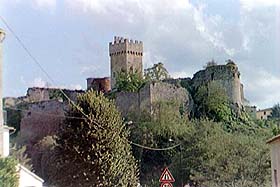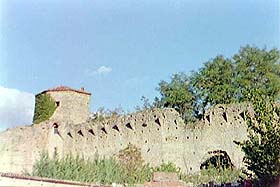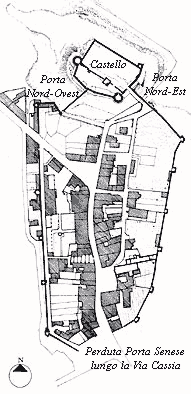Staggia Castle and Town Walls
 |
 |
| The castle. | The town walls. |
The strengthened town of Staggia with its medieval castle is in the council of Poggibonsi, province of Siena. It's easily reachable from the exit 'Colle Valdelsa Sud' of the speedway Florence-Siena.
More Photos
Already between the X° and XI°centuries we have news of Staggia and its fortifications. Subsequently the gentlemen of Staggia (family Soarzi) became one of the greatest feudal realities of the Valdelsa. The Soarzi were many times involved in the struggles between Florence and Siena being their castle in the middle of the territories of the two powerful city. This family knew glories and shines during the 12th century but, while the suburb beginning to grow at the feet of the castle, had a rapid decadence during the following century. From the 13th century the suburb was developed quickly, thanks to the proximity of the road Francigena, that interested directly Staggia with one of its branches. At the end of this century the Franzesi, family of the Valdarno Superiore got rich with the commerce in France, bought, magnified and adorned the castle transforming it in a strengthened residence, one of the most original of the time. In 1361 the commercial activities of the Franzesi failed and the fortress was acquired by the Florentine Republic, so it became an important outpost against Siena. Staggia was more times involved in wars of border and in 1372 were carried on necessary works of strengthening of the castle and the town walls for the protection of the suburb. The walls were again strengthened in 1431 and the castle, to which this are chained, became the keep of this great fortified complex. These interventions were effected with the consultation of the great architect Brunelleschi.
The walls of Staggia, joined to the castle on the northern side, are today almost intact, to exception of two short interruptions. They are alternated from square or polygonal towers and still exist traces of the watch walk, particularly the shelves of support in stone. The enclosure was gifted of three gates. The Florentine gate (said also of Northwest) and that of Northeast, both next to the castle, are still intact, while the Senese sets to South is disappeared, destroyed to do sets to a widening of the roadway!
 |
| City map. |
The ancient castle has an irregular plant near to the form of a rectangle, and it rises above a relief. The construction is not directed in reference to the road layout of the walled suburb. The castle is divided through a curtain at the center the inner ward, in two enclosures. This wall is only trace of the first fortification erected by the Soarzi at the end of 1100. This division, although very diffused in the fortifications of other parts of Italy, it's rare to be found in the Tuscan castles. The enclosure toward the suburb, endowed with two mighty cylindrical bastionated towers set to the angles, had the function of residence of the vassal. This part, whose reinforcements goes back certainly to the strengthening effected in the 15th century, was erected by the Franzesi at the beginnings of 14th century. We can still notice some particular that denote the refinement of the construction as a coat of arms on the tower to north, some portals, elegantly worked windows and a big fireplace set to the inside wall of the palace. The other, smaller, enclosure served for secondary purposes, for instance as last shelter for the population in case of yielding of the wall curtain, and it was endowed with square towers similar to those of the city walls, of which only one has remained today partially entire. The principal, and only gate, of the fortification is set in this part of the castle; through another gate posted in the division wall was possible to access the greatest courtyard. The access to the principal entry is unique in its kind, at least in Tuscany: it happens perpendicularly through a ramp that cross the gate of Northeast. So were created two road levels that made independent the traffic from and toward the city from that of the castle. This urbanist solution was greatest for the times and still actual today, thinking about the chaotic traffic of the modern cities!
The castle lies today in a state of abandonment . Only the keep has been object of works of restoration in the past years. The side occupied by the small enclosure is invaded from the vegetation and with serious danger of collapse. Part of the construction has been used even as for long time as deposit of rural materials. This situation mortifies a fortification for centuries contended between two big medieval powers as Siena and Florence.
| More Photos |
| Back to Homepage |
| Back to Castles Index |